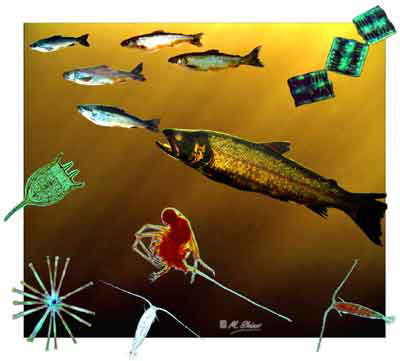
The Open Water or Pelagic Habitat
The open waters permit observation of the classic food chain. Sunlight, together
with the sparse chemical nutrients of a hard rock catchment permit photosynthesis
of the Diatoms, Desmids, Flagellates and other algae (single celled plants) that
make up the phytoplankton. This "primary productivity" is limited by
the peat stained water blocking the much of the vital sunlight.
The algae are grazed by the tiny animals of the zooplankton. The larger ones are
crustaceans such as Copepods and Cladocerans some of which are predators. Daphnia
and Bythotrephes are the main food for the fish of the open water. At night most
of the zooplankton remain near the surface but with dawn they sink into the darkness,
presumably seeking concealment from predation.
The offshore waters are the domain of the Arctic Charr. These fish extend across
the whole surface of the loch in a layer at a depth of approximately 24m by day
but rising towards the surface at night, probably as a response to the zooplankton
migration. They may be present at densities of up to 1000 per hectare though the
biomass has been measured by sonar at only about 20 tonnes. They range in size
from 4cms to approximately 30cms and feed on zooplankton and chironomids. Some
trout also compete at shallower depth and up to a length of 30cms may also feed
on plankton. Larger trout however, hunt among the layers of Charr sometimes swallowing
prey up to a third of their own length.A New Understanding
There is a pronounced increase in fish numbers towards the southern end of the
loch. This raises an interesting question since it is the rocks in the north which
are richer in nutrients. Most of the water however, enters from the southern rivers
whose catchments stretch almost to the west coast of Scotland. The rivers bring
with them organic debris from the peat bogs and woodlands which stain the water
brown. This brown stain limits the penetration of the light so vital for photosynthesis.
These same particles however, are decomposed by bacteria which can be consumed
by protozoans and even the filter feeding Cladocerans, such as Bosmina and Daphnia,
which in turn support the fish population. It has now been discovered that a substantial
amount of the production in the loch does not come from the "primary productivity"
of photosynthesising algal plants but from decomposing terrestrial plant material,
Detailed work on this subject has been undertaken by Lancaster University.
This page copyright Shine, LNP
Close
Window
